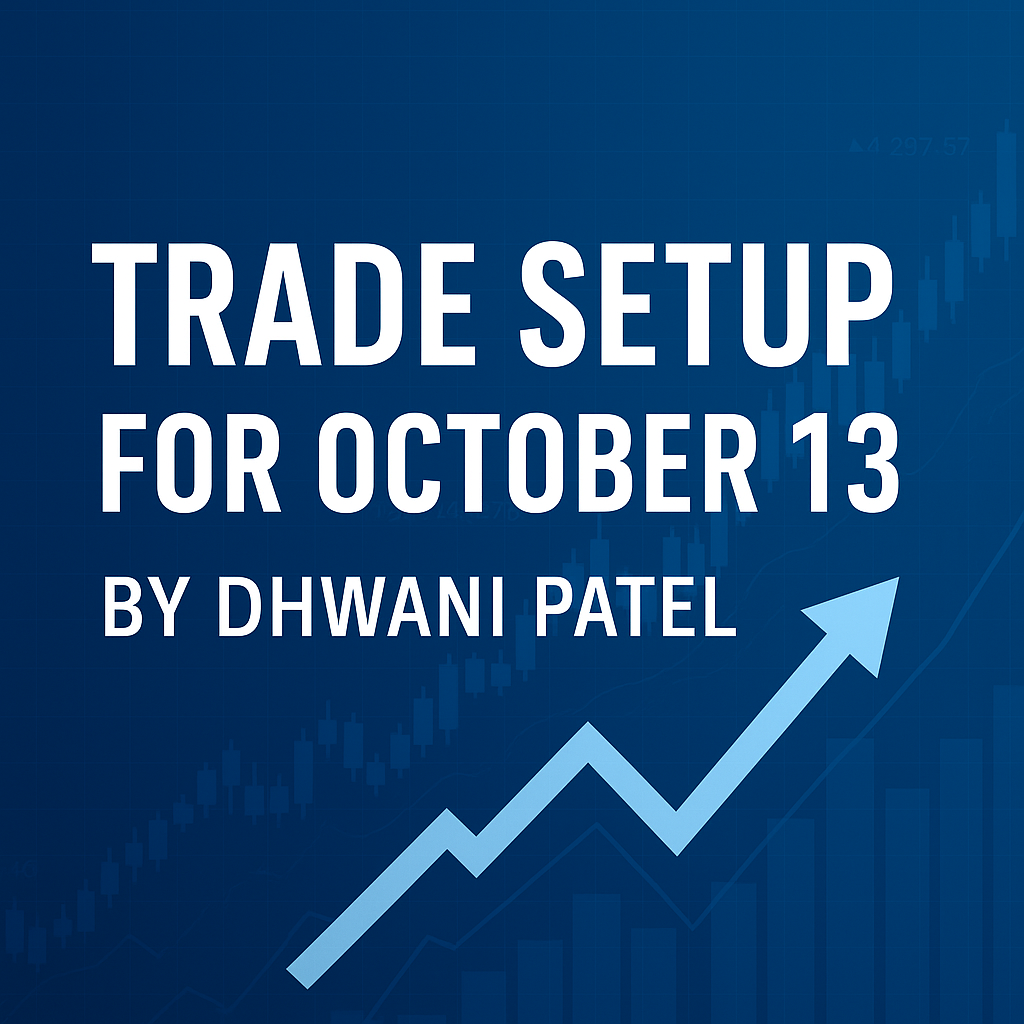
Introduction
As markets gear up for October 13’s opening, traders will lean heavily on cues from global indices, derivative flows, and sector rotation. A few crucial levels and structural cues will likely influence intraday bias and short swing opportunities.
In this Trade Setup for 13 October 2025, dhwani patel, SEBI registered research analyst and founder of Finversify, presents 10 trade-relevant setups to monitor before the bell. Use these as guides—contextual inputs—not rigid prescriptions.
Setup 1 — Nifty 50: structural zones to respect
From pre-market data: resistance near 25,400–25,450, and support around 25,200–25,100 were noted as key zones. These ranges frame any early bias.
Why it matters:
These levels act as magnets or rejection zones. If Nifty stays inside the band, expect choppy trade; a directional breakout (with confirmation) should dictate flow.
How to frame it:
- For futures trading: treat this band as your reference bracket for bias.
- When price pierces beyond resistance or support with volume, lean into the move with controlled exposure.
Setup 2 — Bank Nifty: pivot and triggers
Bank Nifty’s pivot range for the session was identified with resistance near 57,200–57,400 and support around 56,600–56,400. A failure to breach resistance could invite short-term reversals.
Why it’s critical:
Banking index momentum often leads and confirms the broader indices. When Bank Nifty is strong, it lifts financials and related sectors.
Trader’s lens:
- If Bank Nifty clears 57,400 convincingly, that’s a positive trigger for index plays.
- But if it fails, expect rotation into defensive names.
Setup 3 — Call Open Interest Clusters
Key call strikes with heavy open interest include 26,000, 25,800, and 25,600. These strike levels may serve as resistance traps if price approaches them.
Interpretation:
Clusters of call OI often signal where large participants expect upside to slow. If price nears these points, observe volume / OI movement to test strength.
For options players:
- Be cautious of purchasing calls near those strikes unless validation via momentum & trend.
- For derivatives-based participants, these clusters can help define stop zones or hedges.
Setup 4 — Put Open Interest & Support Floor
On the put side, strikes like 25,200, 25,000, 24,800 displayed the largest concentrations of OI. These make for reference floors—especially if Nifty dips.
Why useful:
Strong put OI zones often act as soft supports or magnet zones. A breach below them usually leads to quick downside acceleration.
Use advice:
- Consider these put-heavy levels as defensive zones.
- If price respects them, it can bolster intraday long bias or act as reversal anchors for short swing ideas.
Setup 5 — Bank Nifty Options: mapping financial bias
In Bank Nifty’s options chain, the highest call interest lay near 57,500, followed by 57,000; on the put side, strikes like 56,000 and 55,500 registered heavy OI.
What this suggests:
There is an expectation that Bank Nifty may struggle beyond 57,500; support is likely clustered nearer to 56,000.
For index futures strategies, monitoring how Bank Nifty behaves relative to these option levels gives early cues on where traders are placing hedges or bets.
Setup 6 — Put-Call Ratio & Trader Sentiment
An elevated PCR (above its short-term average) suggests that more participants are buying protection or expecting downside. Conversely, a falling PCR indicates more optimistic sentiment.
Given Mercury’s projection in the pre-market report, shifts in PCR around intraday highs/lows will offer confirmation or warning signs of trend exhaustion.
How to integrate:
- Use PCR movements as a confirming filter — ideally in conjunction with actual option OI and volume.
- Don’t treat PCR moves alone as trade triggers; they’re context aids.
Setup 7 — India VIX: volatility context
Pre-market data showed India VIX in a moderate range, indicating market participants see some room for volatility. A sudden spike could trigger option-based rebalancing.
Why it’s key:
VIX jumps often precede intraday reversals or trend changes — especially when markets are extended.
Tactical note:
If VIX remains steady, trades with tight risk/reward can work well; if it steps up, use smaller sizing or protective hedges.
Setup 8 — Flow Profiles: long builds, unwinds, shorts
The pre-session report flagged notable long build-ups in many stocks, some short covering, and pockets of unwinding. Tracking which names are seeing aggressive positioning can highlight where institutional interest lies.
Why it matters:
These flow signals often lead price — especially when they align with technical patterns.
Usage idea for swing traders:
- Filter for names with rising OI + rising price as candidates for multi-day trades.
- Names with price dropping while OI increases are caution flags — potential shorts or traps.
Setup 9 — Delivery Data & F&O Bans
High delivery percentages in certain stocks indicate actual accumulation rather than intraday noise. Note also which stocks are in the F&O ban list — such names behave erratically because new positions are limited.
Why important:
If a name is seeing high delivery + participation, it’s more likely to have sustainable momentum. Banned names, conversely, pose added structural risk.
Practical use:
- Favor stocks with good delivery for swing exposure.
- Avoid placing leveraged bets on banned names unless you are fully aware of margin/limit constraints.
Setup 10 — Macro Cues & Global Markets
Global markets, US yields, crude trends, and currency moves continue to set the backdrop. Pre-market summary indicated that US futures were marginally down, crude oil prices were firm, and Asian peers opened with mixed cues.
Why it’s relevant:
Domestic flows (especially FII) often depend on global risk appetite. A shift in US or commodity cues can cascade quickly into Indian markets.
How to stay prepared:
- Always glance at US futures and crude before launching trades.
- If global cues weaken mid-session, favor sectors that are less cyclical or high-beta defense.
Building a Practical Checklist from These Setups
To help convert these 10 insights into structured approach, here’s a sample checklist (educational — not trade instructions):
- Pre-market scan (30 min before open):
- Validate Nifty relative to 25,400–25,450 reference band
- Check Bank Nifty relative to its 57,200 / 56,600 pivot zones
- Locate top 3 call and put OI clusters
- Review PCR trend & India VIX heading
- Bias formation:
- If price opens above 25,650 and sustains, consider bullish bias; if below 25,200, remain cautious
- Bank Nifty’s direction can signal relative strength or weakness
- Trade entry logic (for futures / swing / options):
- Favor trades aligned with direction and somewhere away from OI clusters (to avoid getting trapped)
- Ensure validation via volume + OI change
- Risk / sizing discipline:
- In volatile conditions or near OI-heavy zones, reduce size
- Use clear stop-loss zones (e.g. just beyond OI cluster or support zones)
- Intra-session monitoring & re-bias:
- Watch whether calls/puts OI shift aggressively
- Reassess flows (long build/unwind) and sector rotation mid-session
- Use PCR change + VIX movement to adjust bias or scale down exposure
This framework aligns with index futures trading strategies India and meshes well with swing trade principles.
Final Thoughts & Disclaimer
The Trade Setup for 13 October 2025 lays out structured cues — from index zones, option flows, Bank Nifty pointers, to macro heads-up.
All trading and investment decisions are subject to market risk.
Disclosure & Disclaimer: dhwani patel (SEBI Registration No. INH200008608) is a SEBI registered research analyst. This blog is for informational and educational purposes only, and does not constitute investment advice or a recommendation to buy/sell securities. Market conditions change, and readers should perform their own due diligence or consult a qualified financial advisor. SEBI does not endorse or approve any research provided by analysts.
